Ipswich Social Settlement (demolished 1960/1)
Although there is nothing left of the Social Settlement today,
it is significant that the new Suffolk Record Office (renamed in 2020
'The Hold') occupies the same site, although set back from Fore Street.
It is worth including the Settlement on this website not only because
it carried lettering on its facade, but because of its social
importance in the story of Ipswich.
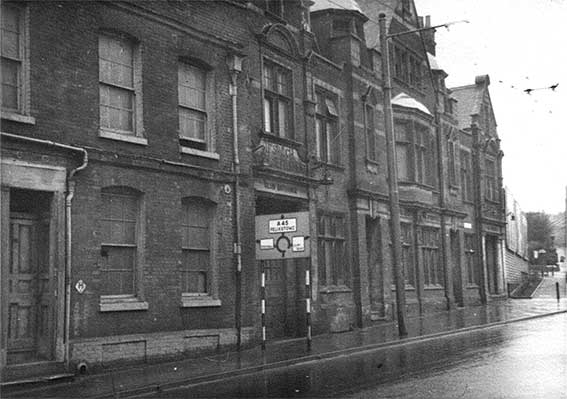 Courtesy
Ipswich Society
Courtesy
Ipswich Society
Above: the Settlement closed up, dirty and dilapidated in 1960 with, at
the far right a view up Back Hamlet.
There is an 'H' hydrant enamelled sign and boot-scraper at left.
A large road sign (the black-and-white striped posts
indicate this early road sign), which obscures the west entrance,
shows the Duke Street roundabout layout:
‘Foxhall, A45
Felixstowe, Cliff Quay’
The tall, cast iron post carries trolley bus power lines.
The lettering:
West side:
‘IPSWICH
SOCIAL SETTLEMENT
CLUB ENTRANCE’
Centre:
‘FOR GOD AND THE PEOPLE’
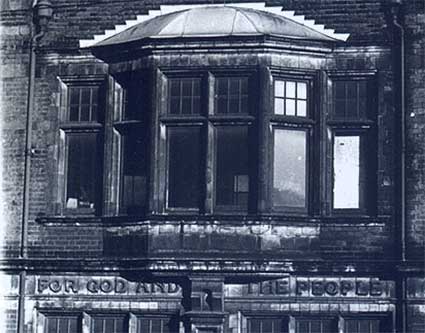 Image by
Brian Jepson, courtesy
Ipswich Society
Image by
Brian Jepson, courtesy
Ipswich Society
East side:
‘IPSWICH
SOCIAL SETTLEMENT
HALL ENTRANCE’
The Social Settlement was intended to alleviate the high levels of
poverty and lawlessness in St Clement parish at the end of the 19th
century. Some timber-framed medieval buildings stood on this site and
in 1896-97 they were substantially altered to create a Social
Settlement. In 1899 a large public hall was added at the rear and
presumably the medieval buildings at the front were demolished to be
replaced by a new residential building on three floors with 16
bedrooms, designed in 1902 for benefactor, Daniel Ford Goddard, by Eade
& Johns Architects. It was in Edwardian free-style, red brick with
stone dressings, symmetrical with a large central gable, oriel bay
windows & flanked by turret gables with copper cupola roofs.
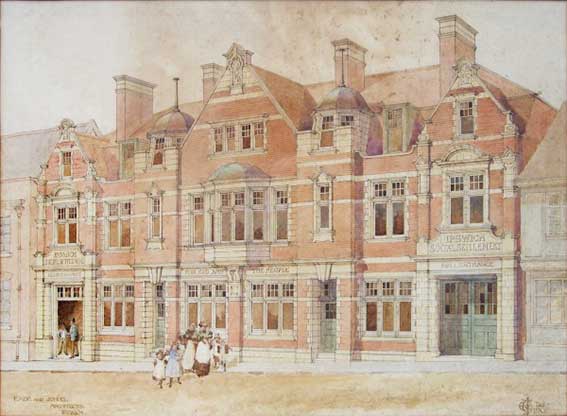 Courtesy Ipswich Society
Courtesy Ipswich Society
Above: Eade & Johns 1902 architect's visualisation of the
new facade for the Social Settlement, showing the red brick with stone
dressings finish, plus all the lettering.
This institution stood opposite the present-day University of Suffolk
Waterfront Building, now the site of Suffolk County Council’s The Hold.
It was in a dilapidated state by 1961; by that time it had a very
fifties-style advertising hoarding and trellis to the right. The Social
Settlement was demolished as part of the Fore Street Improvement
Scheme, in preparation for the visit of Queen Elizabeth II to open the
newly-built Suffolk Civic College.
We are indebted to the mini-site devoted to The Fore Street Facelift 1961
on the Ipswich Society's website (see Links)
for information and images.
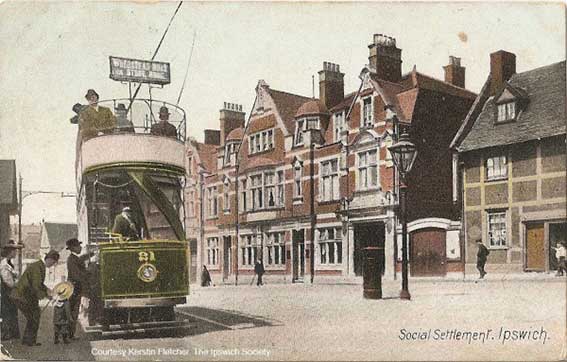 Courtesy
Ipswich Society
Courtesy
Ipswich Society
The above hand-tinted postcard from the collection of Kerstin
Fletcher shows the Social Settlement in the background,
looking rather fine in the 1904 sunshine. Passengers in their Edwardian
dress board the no. 21 tram at the left. Note the lamp-post and pillar
box in the middle of a wide Fore Street with little traffic. The
long power connector is visible, with the post carrying overhead
electricity cables shown in the left background.
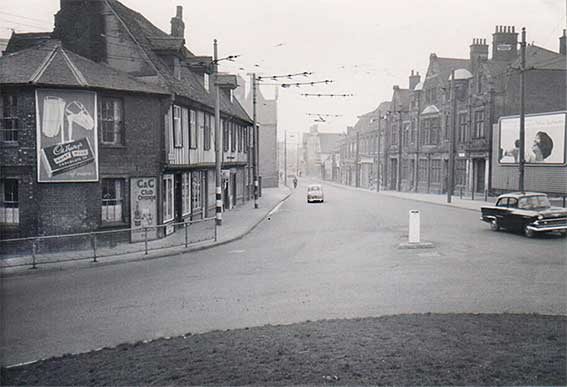 Courtesy
Ipswich Society
Courtesy
Ipswich Society
Finally, we are back at the pre-1961 scene, taken from the
centre of Duke Street roundabout, looking west down Fore Street. The
first thing that strikes one is the dramatic lack of traffic. Then, the
billboards (from left):
'Cadbury's Dairy Milk Chocolate ... of course!' (a glass-and-a-half of
full-cream milk
in every pound bar), 'C&C Club Orange' and a fourteen-sheet
billboard advertisement at the right (on trellis support): a laughing
woman promotes alcohol (probably Mackeson milk stout).
The 1620 buildings at left
have survived;
much else in this photograph has disappeared or changed, including the
Social Settlement beyond the billboard on the right.
Home
Please email any comments
and contributions by clicking here.
Search Ipswich
Historic Lettering
©2004 Copyright
throughout the Ipswich
Historic Lettering site: Borin Van Loon
No reproduction of text or images without express
written permission
 Courtesy
Ipswich Society
Courtesy
Ipswich Society Image by
Brian Jepson, courtesy
Ipswich Society
Image by
Brian Jepson, courtesy
Ipswich Society Courtesy Ipswich Society
Courtesy Ipswich Society Courtesy
Ipswich Society
Courtesy
Ipswich Society Courtesy
Ipswich Society
Courtesy
Ipswich Society